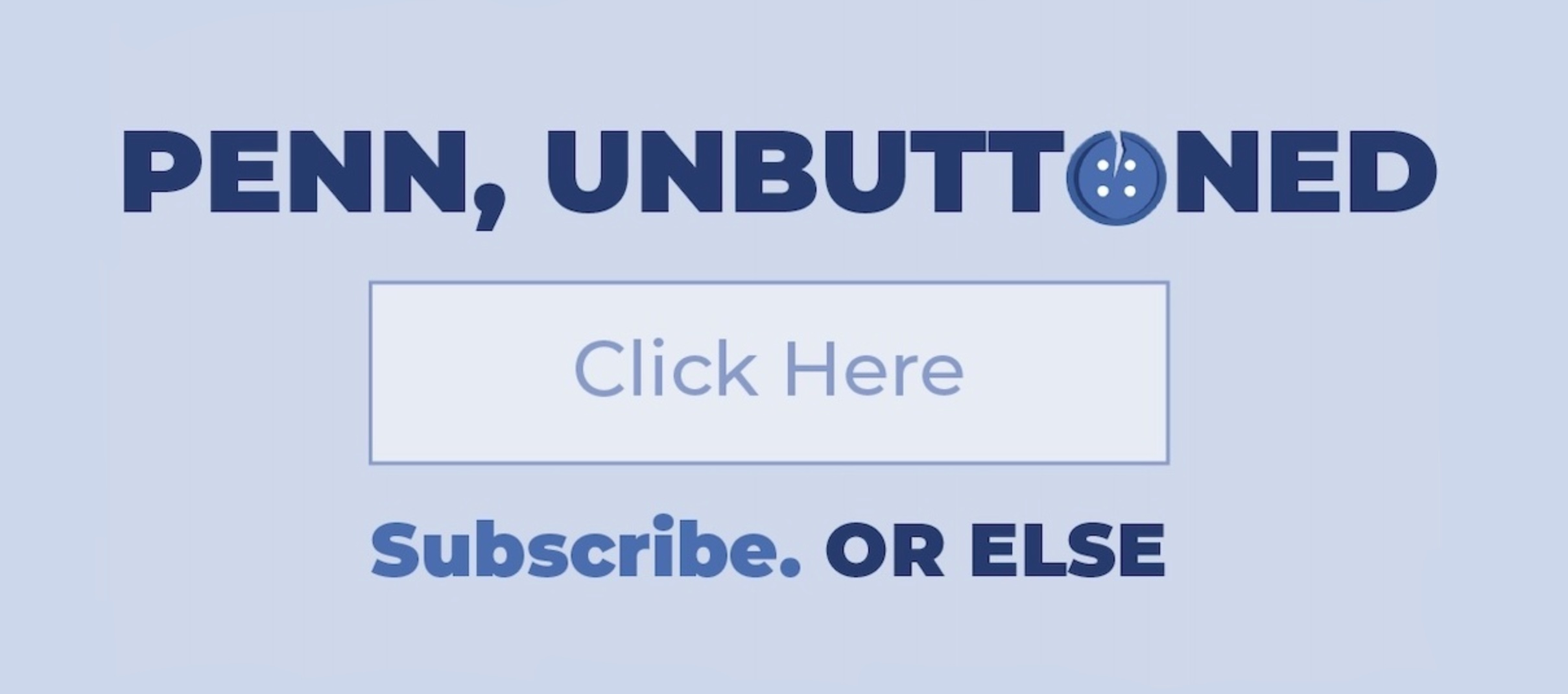Ever since the economy went all wack, Prez A-Gut has been sending out periodic campus-wide emails reassuring students that Penn is doing a-okay. Last week we learned that we're rolling in the dough, and today A-Gut provided us with some more facts and figures. The takeaways:
- Donations to the university this year were the second highest in Penn's history, totaling $440 million.
- The endowment is down 15.7%, outperforming the market by more than 10%.
- Penn has saved $44.6 million in the past six months ($11 million of which was a result of "a variety of human resource actions").
- The financial aid budget is up 16.4%, adding to the 43% increase Penn has seen in the past five years.
See the full email after the jump.
August 10, 2009Dear Members of our University Community:
It has been nearly a year since I first wrote to you about how we at Penn were being affected by the economic downturn that continues to challenge businesses, governments and universities across the country. As we prepare to begin a new academic year, I want to update you on Penn's financial position and the outcome of decisions we have made during this economic recession.
While some positive economic indicators have been recently reported, we still do not know exactly how long the recession will continue or how deeply it will challenge individuals and institutions.
Despite this uncertainty, Penn closed the most recent fiscal year in sound financial condition. Moreover, we enter fiscal year 2010 with a balanced budget. This good news is the direct result of your hard work and commitment to the priorities of our University.
In previous messages, I outlined our broad institutional cost containment goals. (http://www.upenn.edu/pennnews/economy.php) Our community is following through on these goals in smart and innovative ways, enabling us to move forward with our highest priorities under the Penn Compact: increasing access by making a Penn education affordable to every student who enrolls here; integrating knowledge by hiring and retaining the finest teacher-scholars; and furnishing our faculty, students, and staff with the resources needed to engage communities locally and globally.
At this time, I would like to share with you some important examples of our strong fiscal management during these challenging economic times.
RAISING RESOURCES
Penn's $3.5 billion Making History Campaign this past year yielded the second best performance in the history of the University: $440 million in cash receipts were collected based on pledged donations and $398 million of new commitments were made by generous and devoted supporters of Penn. Our participation rate for alumni giving remained close to the record high of our campaign kick-off year.
At fiscal year end, with three years remaining in the Making History campaign, we had raised 70 percent of our $3.5 billion campaign goal. Moving forward, we are mindful that the pace of new commitments may slow down until the economy recovers, but our success to date puts us in a strong position to meet our campaign goals. I am grateful to everyone who has contributed to our Making Historycampaign, and to our Deans, Vice President John Zeller, and the entire Development and Alumni Relations staff across the University for their strong stewardship efforts.
MANAGING THE ENDOWMENT
We expect the Penn endowment to report a loss of 15.7 percent for the fiscal year ending June 30, 2009. The endowment significantly outperformed the S&P500 index (which was down 26.2 percent). We have benefited from a well-diversified portfolio with a core position in Treasuries, a focus on quality stocks with strong balance sheets, and a strong emphasis on risk management. Our endowment performance also reflects a decision in early 2008 to reduce equity exposure.
As important, the endowment has the necessary liquidity to meet our capital commitments and endowment payouts into the foreseeable future. While concerned about the economic environment going forward, I am pleased that the endowment is well positioned to capitalize on new investment opportunities.
I am especially pleased that, under the leadership of our Chief Investment Officer Kristin Gilbertson and our Investment Board, the talented team in our Office of Investments took strategic actions to protect Penn leading up to the crisis, which both reduced our losses and improved the long-term prospects for the Penn endowment.
CONTAINING COSTS
We set an 18-month period to reach our University-wide targeted cost containment goals of $58 million; we have met over 75 percent of these goals in the first six months, with a year left to realize the balance. We have saved a total of $44.6 million through initiatives such as the delay or cancellation of $30 million in capital projects, $11 million through a variety of human resource actions, and $3.6 million in discretionary spending through reductions in travel and conference participation. I appreciate the many initiatives taken and sacrifices made across the campus community to meet our cost containment goals.
The strategies that have led to this success will remain in effect through June 30, 2010, and I am confident we will meet our target. By working effectively and swiftly, the University to date has avoided a mass reduction in workforce or across-the-board spending cuts.
While we are efficiently using our resources, we still face on-going challenges. As you are aware, Governor Rendell recently proposed a revised Commonwealth budget for FY10, which includes a 24 percent cut to the annual appropriation for Penn Vet. This cut places intense pressure on Penn Vet, Pennsylvania's only school of veterinary medicine, which relies on Commonwealth support for approximately 35 percent of its revenues. Penn Vet has put in place a plan to address the Commonwealth shortfall. We are hopeful that the budgetary impasse in Harrisburg will soon be resolved and that a portion of the appropriation for Penn Vet will be restored to mitigate the devastating impact of such deep cuts on both the Commonwealth and Penn Vet.
HONORING OUR COMMITMENTS IN CHALLENGING TIMES
Sound financial management strategies have enabled us to sustain key priorities in student financial aid, teaching, and research. Our commitment to increasing access to a Penn education for all qualified students, regardless of their economic circumstances, continues unabated. To that end, we have increased our financial aid budget this year by $18.7 million, or 16.4 percent. This increase comes on top of the 43 percent increase in our financial aid budget since 2004.
This September, for the first time in Penn's history, all undergraduates who are eligible for financial aid will receive grants rather than loans in their aid packages. Students from typical families with income less than $40,000 will pay no tuition, fees, room or board. Students from typical families with incomes less than $90,000 will pay no tuition and fees. Ten percent of the students in Penn's incoming class of 2013 are the first in their families to attend college.
To attract the best graduate students, we have increased base stipends by 56 percent since 2004 for graduate students in Arts and Sciences and by 22 percent for all Penn graduate students.
We are moving forward on the Penn Connects campus master plan with important capital projects that will contribute to the teaching and research mission of Penn, while also enhancing the beauty and quality of life on our campus.
· In the fall of 2009, we will cut the ribbon on the new Annenberg Public Policy Center and the new Roberts Proton Therapy Center. We will also break ground on Penn Park, the 24-acre signature project of our Penn Connects campus master plan. Penn Park, which extends from Franklin Field and the Palestra to the Schuylkill River, will increase campus green space by 20 percent, further our sustainability goals, and provide new athletic and recreational space - plus beautiful vistas - for our entire community to enjoy.
· In spring of 2010, we will open the new Weiss Pavilion - fitness center and weight room - at Franklin Field and the newly renovated and expanded Music Building.
The progress made on these and other capital projects is a testament to Penn's smart planning and sound financial management.
Penn is also aggressively pursuing opportunities represented by the American Recovery and Reinvestment Act. Penn faculty have submitted approximately 850 grant applications and more than $550 million in requested funding to institutions such as the National Institutes of Health and the National Science Foundation. Penn researchers already have been awarded $30 million in funding, with the bulk of research awards yet to be announced. More stimulus money is expected over the years ahead, which would provide more financial assistance and tax credits for college students and their families, and more for scientific research.
As we move into the new academic year and welcome a new undergraduate class to campus, I am pleased to report that Penn continues to make progress on our highest strategic priorities. This is possible only through the strong commitment, dedication, and vision of our campus community. I know you join me in thanking our wonderful Trustees, Overseers, Deans, Vice Presidents, Resource Center Directors and Departmental Chairs for their stewardship during these challenging times.
I deeply appreciate your sacrifices, large and small, your support, and your dedication in these difficult times. Together we have been able to make Penn more affordable to the most talented and diverse student body, to recruit and retain an eminent faculty, and to become a model of interdisciplinary education and civic engagement.
Sincerely, Amy Gutmann








